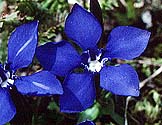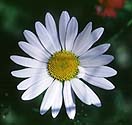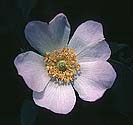|

Alpine
Flowers
Many species
of plants and flowers specific to the Alpine habitat cover the
mountains, prairies and forests of Savoie during the growing
season. This page, which will grow over the course of time, aims
to present some of the most beautiful wildflowers of the region.
Some of these are endangered or threatened species, and should
never be picked. In any case, like most wildflowers, they wilt
rapidly and it is a waste to pick them. Entertain yourself therefore
by finding them in their habitat, and use the form below to start
a "life list" of the the species you have learned to
recognize.

Mountain
Flowers
These flowers
grow at higher altitudes, above 1000m (3300ft). One can find
them at different elevations through the months of spring and
summer, as the spring and summer arrive later the higher you
go. If, for example, you can find spring gentians around 1500m
in June, you will find them above 2000m in July, and higher still
in early August.
Mountain flowers
are generally very short in order better to resist the strong
winds and snows which would break taller plants.
Some hikers
pick these flowers, explaining that by being careful not to take
the root, they are not killing the plant. This may be true, that
the plant does not die right away, but by depriving the plant
of its means of reproduction, each picked flower brings the species
closer to utter extinction. Therefore, do as the Sierra Club
suggests, take nothing but pictures, leave nothing but footprints!
But be careful not to leave the designated trails, and leave
the blooms for all to enjoy!

 Arnica. This pretty flower, found in yellowish
or orange colors, somewhat resembles the common dandelion's.
Its bloom however has fewer petals, and the arnica never grows
tall, unlike some dandelions which can be 50cm tall. One finds
the arnica in mountain meadows as well as above timberline. Arnica. This pretty flower, found in yellowish
or orange colors, somewhat resembles the common dandelion's.
Its bloom however has fewer petals, and the arnica never grows
tall, unlike some dandelions which can be 50cm tall. One finds
the arnica in mountain meadows as well as above timberline.
 The purple gentian is the signature flower
of the French Alps. Often depicted on coats of arms and decorations,
it usually grows in bunches of some dozens of small plants, usually
on limestone or chalky ground. There are two closely related
species which look almost the same: Koch's gentian and the acaule gentian are not easily distinguished by
the average hiker. These are protected species! Do not pick! The purple gentian is the signature flower
of the French Alps. Often depicted on coats of arms and decorations,
it usually grows in bunches of some dozens of small plants, usually
on limestone or chalky ground. There are two closely related
species which look almost the same: Koch's gentian and the acaule gentian are not easily distinguished by
the average hiker. These are protected species! Do not pick!
 The spring gentian, which, as its name indicates, is one
of the first flowers to bloom after the snow melt, is one of
the bluest flowers in the world. Its intense color is surprising,
and you may be fortunate enough to find a whole bunch blooming
together. Smaller than the bell-shaped purple gentian, it has
five petals and grows on limestone and chalk mountains.
This is a
protected species! Do not pick! The spring gentian, which, as its name indicates, is one
of the first flowers to bloom after the snow melt, is one of
the bluest flowers in the world. Its intense color is surprising,
and you may be fortunate enough to find a whole bunch blooming
together. Smaller than the bell-shaped purple gentian, it has
five petals and grows on limestone and chalk mountains.
This is a
protected species! Do not pick!
 The
familiar daisy
has its alpine
variety; shorter than the garden flower, it is found in meadows
as high up as the timberline; it does not grow above timberline
where the weather conditions are too rigorous. One generally
finds that, the higher the altitude, the shorter the flowers
grow. It is their way of coping with high winds. The
familiar daisy
has its alpine
variety; shorter than the garden flower, it is found in meadows
as high up as the timberline; it does not grow above timberline
where the weather conditions are too rigorous. One generally
finds that, the higher the altitude, the shorter the flowers
grow. It is their way of coping with high winds.
 The
Lady's Slipper
(sabot de Vénus), is one of the very rare orchids found in our
mountains. It grows in the damp underbrush, in forest clearings,
at the foot of the mountains. Some hikers like to pick these
flowers, and in so doing kill the plant. They believe, in error,
that picking the flower but leaving the rest of the plant, will
allow it to grow again the following year. Unfortunately, this
is not the case: the plant needs its flower to reproduce and
survive. This is a protected species!
Do not pick! The
Lady's Slipper
(sabot de Vénus), is one of the very rare orchids found in our
mountains. It grows in the damp underbrush, in forest clearings,
at the foot of the mountains. Some hikers like to pick these
flowers, and in so doing kill the plant. They believe, in error,
that picking the flower but leaving the rest of the plant, will
allow it to grow again the following year. Unfortunately, this
is not the case: the plant needs its flower to reproduce and
survive. This is a protected species!
Do not pick!

Forest
and Meadow Flowers
 The wild rose is a relatively common plant; it is
a bush which grows near the forest's edge, and is claimed to
be the ancestor of the garden rose. Its bloom, white or light
pink in color, has a delicate fragrance; like the rose, it too
has thorns. The wild rose is a relatively common plant; it is
a bush which grows near the forest's edge, and is claimed to
be the ancestor of the garden rose. Its bloom, white or light
pink in color, has a delicate fragrance; like the rose, it too
has thorns.
MORE
COMING SOON!
Print the
form below and take it with you on a hike.
Note which flowers you have seen. |

 Arnica. This pretty flower, found in yellowish
or orange colors, somewhat resembles the common dandelion's.
Its bloom however has fewer petals, and the arnica never grows
tall, unlike some dandelions which can be 50cm tall. One finds
the arnica in mountain meadows as well as above timberline.
Arnica. This pretty flower, found in yellowish
or orange colors, somewhat resembles the common dandelion's.
Its bloom however has fewer petals, and the arnica never grows
tall, unlike some dandelions which can be 50cm tall. One finds
the arnica in mountain meadows as well as above timberline. The purple gentian is the signature flower
of the French Alps. Often depicted on coats of arms and decorations,
it usually grows in bunches of some dozens of small plants, usually
on limestone or chalky ground. There are two closely related
species which look almost the same: Koch's gentian and the acaule gentian are not easily distinguished by
the average hiker. These are protected species! Do not pick!
The purple gentian is the signature flower
of the French Alps. Often depicted on coats of arms and decorations,
it usually grows in bunches of some dozens of small plants, usually
on limestone or chalky ground. There are two closely related
species which look almost the same: Koch's gentian and the acaule gentian are not easily distinguished by
the average hiker. These are protected species! Do not pick! The spring gentian, which, as its name indicates, is one
of the first flowers to bloom after the snow melt, is one of
the bluest flowers in the world. Its intense color is surprising,
and you may be fortunate enough to find a whole bunch blooming
together. Smaller than the bell-shaped purple gentian, it has
five petals and grows on limestone and chalk mountains.
This is a
protected species! Do not pick!
The spring gentian, which, as its name indicates, is one
of the first flowers to bloom after the snow melt, is one of
the bluest flowers in the world. Its intense color is surprising,
and you may be fortunate enough to find a whole bunch blooming
together. Smaller than the bell-shaped purple gentian, it has
five petals and grows on limestone and chalk mountains.
This is a
protected species! Do not pick! The
familiar daisy
has its alpine
variety; shorter than the garden flower, it is found in meadows
as high up as the timberline; it does not grow above timberline
where the weather conditions are too rigorous. One generally
finds that, the higher the altitude, the shorter the flowers
grow. It is their way of coping with high winds.
The
familiar daisy
has its alpine
variety; shorter than the garden flower, it is found in meadows
as high up as the timberline; it does not grow above timberline
where the weather conditions are too rigorous. One generally
finds that, the higher the altitude, the shorter the flowers
grow. It is their way of coping with high winds. The
Lady's Slipper
(sabot de Vénus), is one of the very rare orchids found in our
mountains. It grows in the damp underbrush, in forest clearings,
at the foot of the mountains. Some hikers like to pick these
flowers, and in so doing kill the plant. They believe, in error,
that picking the flower but leaving the rest of the plant, will
allow it to grow again the following year. Unfortunately, this
is not the case: the plant needs its flower to reproduce and
survive. This is a protected species!
Do not pick!
The
Lady's Slipper
(sabot de Vénus), is one of the very rare orchids found in our
mountains. It grows in the damp underbrush, in forest clearings,
at the foot of the mountains. Some hikers like to pick these
flowers, and in so doing kill the plant. They believe, in error,
that picking the flower but leaving the rest of the plant, will
allow it to grow again the following year. Unfortunately, this
is not the case: the plant needs its flower to reproduce and
survive. This is a protected species!
Do not pick! The wild rose is a relatively common plant; it is
a bush which grows near the forest's edge, and is claimed to
be the ancestor of the garden rose. Its bloom, white or light
pink in color, has a delicate fragrance; like the rose, it too
has thorns.
The wild rose is a relatively common plant; it is
a bush which grows near the forest's edge, and is claimed to
be the ancestor of the garden rose. Its bloom, white or light
pink in color, has a delicate fragrance; like the rose, it too
has thorns.